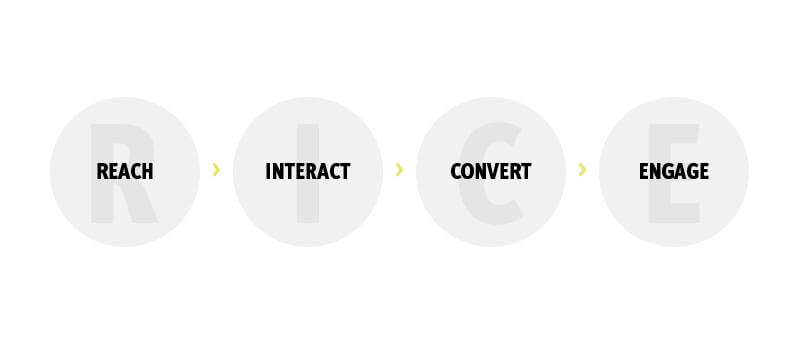Sitting in front of your computer, staring at Facebook ads manager and feeling daunted? You’re not alone. Figuring out how to write effective Facebook ad copy for your business is a daunting task for first-time creators. However, considering that the average person spends at least 1.72 hours each day on social media, it’s an advertising outlet worth pursuing. That’s why we’ve put together these tips on Facebook ad copywriting and included best practices so you understand how to make a good Facebook ad that’s effective and produces the ROI you’re looking for.
The Effects Of Good Ads
Facebook advertising is the most effective way to ensure your brand actually reaches new audiences on the platform. A few years ago, Facebook changed algorithms for organic reach, prioritizing personal posts over business content. As a result, businesses posting organic content have very low visibility in the Facebook news feed.
However, taking advantage of paid ad campaigns or boosting your posts allows you to override that limitation and regain visibility in users’ news feeds. In a Facebook study done by Wordstream, they noticed that businesses with active ad campaigns saw a 77% increase in followers compared to businesses not running any advertising.
Followers should not be the most important metric you use to gauge your Facebook advertising’s success. (Although, earning more followers does show you’re increasing brand awareness and it provides an opportunity to drive more new traffic to your website.)
You may find social campaigns can help you meet additional goals, such as growing your lead list and increasing sales, gaining more email subscribers, boosting phone calls, and more.
Successful Facebook Ads Strategy
If you’re just starting to do ad campaigns, it’s important to set realistic goals. Too often, businesses get ahead of themselves and expect leads or conversions the moment they begin social advertising. However, most successful Facebook ads have one thing in common — they are the result of time and experimentation.
Facebook advertising moves through four stages, which are adequately summarized in a digital marketing strategy known as “R.I.C.E.”

Initially, your ad campaigns are working to build your reach among new audiences. However, it may take several months (or campaigns) to achieve this. You need to spend time using trial and error testing to find what content your intended audience responds to best on Facebook.
Once your reach is established, then you can move into the interacting phase. The goal of your advertising here is to persuade your audience to take action and learn more. You want to direct them to your website and make sure you have content they’ll want to explore.
After you see your ads are consistently drawing new audiences who spend time on your website, it’s time to convert them. Now you can start writing Facebook ad copy that converts and sells. You’ve built up your reach and the value of your content on Facebook, which in turn gives you social credibility that appeals to people ready to make a purchase decision.
Once you’re seeing your advertising lead to conversions, you’re then left with the responsibility to continue engaging audiences with your advertising. In this stage, you’re focusing on using your ads to create brand loyalty and continue offering value to customers to encourage repeat business.
The key takeaway here is that you first need to build social equity on Facebook before you can sell. Now that we’ve covered the strategic stages you can use to advance your Facebook ads, it’s time to look at how to write effective Facebook ad copy.
Getting Started: How To Write Effective Facebook Ad Copy
If you’re wondering how to write effective Facebook ad copy, it all starts by putting a framework into place. Successful Facebook ads usually employ the following practices.
1. Start With Audience Targeting
Know who you’re trying to talk to and don’t guess based on your gut. Instead, look at your audience demographics from your website’s tracking. Consider who your sales team is talking to. Research the data your business has to find out more about your audience. Ask yourself:
- What demographic is visiting my website currently?
- Does my desired demographic use Facebook?
- What is their job title?
- Which hobbies or topics interest them?
- Where is their geographic location?
After you’ve found the data to answer these questions, you can use Facebook ads manager to build a target audience for your ad campaign. But it’s important to do this step first so that you can make sure you write ad copy tailored to your actual audience.
2. Write Short & Simple Content
Some advertisements can break this rule, but at the beginning of your advertising campaign, you should write content to fit the character limits so your text isn’t cut off and users can see it all at once. Facebook ad character limits are:
- 25 characters for a headline
- 30 characters for a link description
- 125 characters for ad copy (primary text)

This is where good writing comes into play. Follow the K.I.S.S. (Keep It Simple, Smartie) principle. Write simply and use language your audience understands. Don’t use big words or try to impress them with industry jargon. Think about what pain points trigger your audience emotionally, lead with that, and present your brand as the solution. The headline is a great place to hook them, the link description shows the solution, and the main ad copy is where you do your persuading.
3. Always Choose A Call To Action (CTA) To Match Your Strategy
You probably already have a CTA in mind as you’re writing, but it’s worth devoting a section talking about this. Since you’re just beginning Facebook advertising, you’re still in the reach or interest phase, so one of your better CTA options is to encourage people to “Learn More.” As you move further along in your social media strategy, then you can begin experimenting with other CTAs.
4. Make Sure Your Copy Matches Your Visual
If your ad campaign doesn’t look cohesive, it’s a huge turn-off for Facebook users. Social platforms are heavily visual and people have come to expect clear, high-quality images. If your photo is distorted, blurry, or too posed, you won’t see good engagement from your ad campaign. Thankfully you don’t have to be a design expert to figure out how to optimize the visual part of your ad. Facebook provides straightforward visual guidelines about what looks optimal in an ad. Plus if you’re pulling stock images from a provider like Shutterstock or Adobe, you can feel confident they’ll be good quality for social.
Need Some Inspiration? As you begin to draft a campaign, here’s a compilation of some great Facebook ad copy examples to get you started. There’s also a great breakdown for each one detailing what they did right in the ad copy and the visuals used. And while we recommend starting with image-based ads when you’re new, eventually you’ll want to look into exploring other types of Facebook ads (video, carousel, etc.) to see what resonates with your audience.
Measuring Your Facebook Ad Results
It’s easy to fall into basing your assessment around vanity metrics, such as likes or comments, but those aren’t the best criteria to base your conclusions on. The way you measure success depends on the goal of your ad campaign. However, here are some metrics to keep in mind as you start your advertising.

Ad Frequency
Ad frequency shows how many times Facebook users saw your ad. If you’re trying to increase brand awareness, you likely want your frequency to be around 3-4 times.
However, if you’re at the stage where you’re trying to convert users, it’s better to keep that frequency number low. Otherwise, you risk annoying users with a very direct ad they don’t have an interest in.
Cost-Per-Click (CPC) or Cost-Per-Result (CPR)
Facebook either charges you per impression or per click, depending on which option you choose. If you’re just starting out, cost-per-click is a more budget-friendly option.
Just don’t be startled, as your CPC or CPR may initially be high. One way to gauge your ad’s success is if that dollar amount starts decreasing over its run time. Generally, you want your Facebook ad’s click-through rate to be $2 or under. If it’s not, you’ll want to try adjusting your campaign’s targeting, copy, or run time, depending on what you think is driving the high cost.
Reach & Results
When you’re starting social ads, this metric can show you how many different people are seeing your ad. Initially, you want to see a large reach to raise brand awareness.
Over time, the goal is to eliminate any waste in your reach, such as people in the wrong location seeing your ads or demographics that aren’t a good fit. From there, you want to see your number of results increase compared to your previous campaigns.
Your results will be different depending on what Facebook objective you use while setting up your ad. In the beginning stage of R.I.C.E., the traffic objective works well to see how many new users are visiting your website.
Over time, you’ll also want to branch out from the metrics above. Always make sure you’re measuring the metrics that best indicate success according to the goal of your ad, which could be anything from brand awareness to webinar signups.
Create A Holistic Social Media Strategy
Above all else, make sure that your Facebook advertising fits into your goals for social media marketing, especially if you’re active on other platforms. It’s important to make sure your brand is consistent across all platforms.
Plus, you want to make sure your marketing efforts are achieving your business goals. Check out this blog for advice on how you can create your own social media strategy from scratch.

